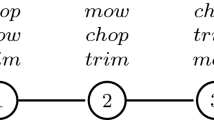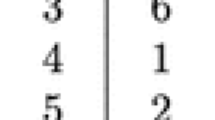Abstract
We have 3 students who wish to share the rent of an apartment together. There is a problem. The bedrooms have different characteristics. How does one assign the bedrooms?. How much will each one pay?. In this article based on the students’ preferences, we will find all envy-free solutions to this problem. In addition, given an efficient assignment, we find all the extreme points of the set of prices that make up these solutions. An efficient assignment together with the centroid of the set of prices is suggested as a solution. In the model there is an implicit proposal of how to obtain envy-free solutions in economies with indivisible goods. Also, the same model can be used to divide a set of chores fairly among agents.









Similar content being viewed by others
Notes
An extreme point of a convex set S is a point in S that cannot be expressed as the convex combination of two other points in S.
References
3B1B 3Blue1Brown NYT: Sperner’s lemma defeats the rental harmony problem. https://www.youtube.com/watch?v=7s-YM-kcKME
Abdulkadiroǧlu A, Sönmez T, Ünver UM (2004) Room assignment-rent division: a market approach. Soc Choice Welf 22:515–538
Alkan A, Demange G, Gale D (1991) Fair allocation of indivisible goods and criteria for justice. Econometrica 59:1023–1039
Asada M, Frick F, Pisharody V, Polevy M, Stoner D, Tsang LH, Wellner Z (2018) Fair division and generalizations of Sperner and KKM-type results. SIAM J Discrete Math 32(1):591–610
Azrieli Y, Shmaya E (2014) Rental harmony with roommates. J Econ Theory 153:128–137
Brams SJ, Kilgour DM (2001) Competitive fair division. J Polit Econ 109(2):418–443
Dehghani S, Farhadi A, Taghi M, Aghayi HM, Yami H (2018) Envy-free Chore Division for An Arbitrary Number of Agents. Proceedings of the 2018 annual ACM-SIAM symposium on discrete algorithms
Diamantaras D, Thomson W (1989) A refinement and extension of the no-envy concept. Econ Lett 30(2):103–107
Frick F, Houston-Edwards K, Meunier F (2020) Achieving rental harmony with a secretive roommate. Am Math Month 126(1):18–32
Gal YY, Mash M, Procaccia AD, Zick Y (2016) Which Is the Fairest (Rent Division) of Them All?. Proceedings of the 2016 ACM conference on economics and computation, July 2016. pp 67–84
Haake C-J, Raith MG, Su EF (2002) Bidding for envy-freeness: a procedural approach to n-player fair-division problems. Soc Choice Welf 19:723–749
Klijn F (2000) An algorithm for envy-free allocations in an economy with indivisible objects and money. Soc Choice Welf 17:201–215
Musin OR (2017) KKM type theorems with boundary conditions. J Fix Point Theory Appl 19:2037–2049
PBS Infinite Series. Splitting Rent with Triangles. Infinite Series. https://www.youtube.com/watch?v=48oBEvpdYSE
Su EF (1999) Rental harmony: Sperner’s lemma in fair division. Am Math Month 106:930–942
Tadenuma K, Thomson W (1991) No-envy and consistency in economies with indivisible goods. Econometrica 59:1755–1767
The New York Times. To divide the rent. Start with a triangle. Divide your rent fairly. April 28, 2014. https://www.nytimes.com/interactive/2014/science/rent-division-calculator.html
Thomsom W (1995) Population-monotonic solutions to the problem of fair division when preferences are single-peaked. Econ Theory 5:229–246
Velez R (2018) Equitable rent division. ACM Trans Econ Comput 6(2):1–25
Acknowledgments
We would like to thank the anonymous referees for their helpful and accurate comments. Also, the author acknowledge support from CONACyT research grant 167924.
Author information
Authors and Affiliations
Corresponding author
Additional information
Publisher's Note
Springer Nature remains neutral with regard to jurisdictional claims in published maps and institutional affiliations.
Appendix
Appendix
Proof of Lemma 1
We will only prove for \(k=1\), the demonstrations of other two cases are similar. Let e be the vector of ones, then
-
(i)
The coordinates of \(v+\rho d^{1}\) add up to one since \( e^{T}(v+\rho d^{1})=1+\rho 0=1.\)
-
(ii)
The first coordinate of \(v+\rho d^{1}\) increases but is still less than one since \(\ \ v_{1}+\rho \le 1\) if and only if \(\rho \le 1-v_{1}.\)
-
(iii)
The second coordinate of \(v+\rho d^{1}\) remains positive as \( v_{2}-\frac{\rho }{2}\ge 0\) if and only if \(\rho \le 2v_{2}.\)
-
(iv)
And finally, the third coordinate of \(v+\rho d^{1}\) is still positive since \(v_{3}-\frac{\rho }{2}\ge 0\) if and only if \(\rho \le 2v_{3}.\)
\(\square \)
Proof of Proposition 2
We will only prove point a), the demonstrations of the other two points are similar. Suppose \(v^\alpha \) and p such that \(v^\alpha _{1}-p_{1}<v^\alpha _{2}-p_{2}=v^\alpha _{3}-p_{3}\) and let \(\rho =p_{1}-v^\alpha _{1}\), then since the coordinates of \(v^\alpha \) and p add to 1,
therefore
Equality in the first coordinate is given by the definition of \(\rho \).
Now let us assume \(p=v^\alpha +\rho d^{1}\in \Delta \) with \(\rho >0\), then
as \(\rho >0\), the first coordinate of \(v^\alpha -p\) is negative. The other two coordinates are positive and equal to each other. \(\square \)
Proof of Proposition 3
As before, we only demonstrate point (d), the other demonstrations are similar. Let us assume \(Ch_{\alpha }(p)=\{1\}\) and let \(\lambda =\frac{2}{3} (v^{\alpha }_{1}-p_{1})-\frac{2}{3}(v^{\alpha }_{2}-p_{2})\) and \(\rho =\frac{4}{3}(v^{\alpha }_{1}-p_{1})+ \frac{2}{3}(v^{\alpha }_{2}-p_{2})\). Therefore,
to get the last equality, it is necessary to do a little algebra. All that remains is to prove that \(\lambda \) and \(\rho \) are positive. As \( Ch_{\alpha }(p)=\{1\}\), we have to \(v^{\alpha }_{1}-p_{1}>v^{\alpha }_{2}-p_{2}\) and \( v^{\alpha }_{1}-p_{1}>v^{\alpha }_{3}-p_{3}\). So clearly \(\lambda >0\), on the other hand,
To demonstrate (d) in the other direction, let \(p=v^{\alpha }+\lambda d^{2}+\rho d^{3}\in \Delta \) with \(\lambda ,\rho >0\) then,
where clearly the first coordinate is the largest, that is, \(Ch_{\alpha }(p)=\{1\}\). \(\square \)
Proof of Lemma 2
Let p be an envy-free price vector and \(\overline{\mu }\in \mathcal {A}\) any assignment. Let us suppose \(\mu (i)=\overline{\mu }(k)\), that is, for the same student \(\mu \) assigns room i to him, while \(\overline{ \mu }\) assigns room k. As p is an envy-free price vector,
by adding both side over the set of rooms, we get the desired result. \(\square \)
Proof of Lemma 3
Let us assume \(p^{1}\), \(p^{2}\in Ef\) and \(\lambda \in [0,1]\), then
and
for every \(k,j\in M\). Multiplying each inequality of (37) by \( (1-\lambda )\) and each inequality of (38) by \(\lambda \), and then adding the corresponding inequalities, we obtain
for every \(k,j\in M\). But this means that \((1-\lambda )p^{1}+\lambda p^{2}\in Ef\). \(\square \)
Proof of Proposition 4
Let the student \(\gamma \) choose the room he/she prefers, then,
If \(\mu (i)=\gamma \) then define \(\mu (j)=\alpha \) and \(\mu (k)=\beta \).
If \(\mu (j)=\gamma \) then define \(\mu (i)=\alpha \) and \(\mu (k)=\beta \).
If \(\mu (k)=\gamma \) then define \(\mu (i)=\alpha \) and \(\mu (j)=\beta \). \(\square \)
Proof of Proposition 5
Let \(\bar{\mu }\) be an efficient assignment and p be an envy-free price vector with respect to \(\mu \). For every \(i\in M\), let k be such that \(\bar{\mu }(k)=\mu (i)\), then since \(\bar{\mu }\) and \(\mu \) are efficient
subtracting on both sides \(\sum _{i\in M}p_{i}=\sum _{k\in M}p_{k}\),
but p is an envy-free price vector, thus
because \(\bar{\mu }(k)=\mu (i)\). In order for (41) to be true, all of the above inequalities must be met with equality. In addition to these equalities, it immediately follows that the p is envy-free price vector with respect to \(\bar{\mu }\). \(\square \)
Rights and permissions
About this article
Cite this article
Sánchez Sánchez, F. Envy-Free Solutions to the Problem of Room Assignment and Rent Division. Group Decis Negot 31, 703–721 (2022). https://doi.org/10.1007/s10726-022-09779-w
Accepted:
Published:
Issue Date:
DOI: https://doi.org/10.1007/s10726-022-09779-w




